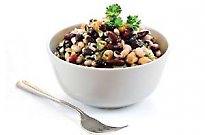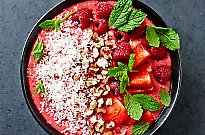
How to make healthy food choices

Want to know the secret to supermarket shopping? Look no further...
While doing your weekly shop at the farmer's market and from local organic producers is the ideal, for many of us, shopping at the supermarket is unavoidable. It can, however, be a nutritional minefield. Rebecca Howden explores the aisles for the best choices
Plan before you go
Wandering around the supermarket can be overwhelming. There is so much choice it can be hard to make good decisions. That’s why Dietitians Association of Australia spokesperson Pip Golley says having a shopping list prepared before you go to the supermarket is essential.
“The best way to make your list is to add to it during the week, and to have a healthy eating plan in place so that you know what should go on it,” says Pip. “Then, when you go to the supermarket you’re really well prepared.”
Avoid temptation
Most of what you should be buying will be located on the periphery of the supermarket. Junk food tends to be in the centre aisles. Avoid the temptation altogether by skipping the areas where fatty and sugary snack foods lurk.
“You can skip the confectionary aisle, you can skip the soft drink aisle,” Pip says. “If you stick to the periphery in general, that’s where you’re going to get your fresh fish, meat and chicken, your dairy, your fruits and vegetables. Only go down the aisles you need to go down.”
Check nutrition labels
Get into the habit of carefully checking the labels of packaged products before you add them to your trolley. Pip says there are two key things to look at on packaged foods: the ingredients list and the nutritional information panel.
“On the ingredients list, ingredients are listed in order of quantity,” Pip explains. “So if you find an ingredients list where sugar is the first item, it’s probably a product that you shouldn’t be eating.”
Similarly, the key things to check on the nutritional information panel are fats (especially saturated and trans fats), sugar and sodium. “When you’re looking at a product, the total fat and sugar contents should each be less than 10 grams per 100 grams,” Pip advises.
It’s also smart to look for foods that are high in fibre, which keeps you feeling full. “Fibre should be at least three grams per 100 grams,” she says.
Navigating the aisles
- Cereals, breads and grains
When you’re shopping for breads and grains, choose wholegrain, multigrain and wholemeal varieties wherever possible. Wholegrains are a great source of insoluble fibre, which helps to slow down digestion, so you feel fuller for longer. It can also help to reduce fat absorption and regulate blood sugar levels, which gives you more consistent energy.
The important thing to remember is that this applies not just to bread, but to cereals, pastas, rice and noodles as well. “People are very used to choosing wholemeal and wholegrain breads, but when it comes to pasta and rice they’re less inclined to do so,” Pip says. “If you do already have wholemeal bread, try to extend beyond that with wholemeal pasta, rice and noodles.”
When it comes to breakfast cereals in particular, it’s important to compare the nutritional labels of different products to look for items that have less sugar and more fibre. “As always, aim for at least three grams of fibre per 100 grams, preferably more. Products like rolled oats have close to 10 grams of fibre per 100 grams,” Pip says.
- Dairy
The dairy section provides you with important nutrients, so add a good selection to your trolley. “For adults, choosing low fat dairy products is key, whether it’s milk, yoghurt, custard or ice cream,” Pip advises. “Again, it’s a matter of checking the nutrition label and looking for products that have the lowest fat and the lowest sugar content. “
For products like yoghurt, which naturally contains a bit of sugar from the lactose, it comes down to comparing different items and choosing the one with the lowest amount of sugar per 100 grams.
- Fruits and vegetables
Spend the most time in the produce section, where you’ll find plenty of fresh fruits and vegetables to fill up your trolley. “Buying seasonal produce is the key to getting the best quality, and it’s also usually cheaper, because it’s often travelling less distance to get there,” says Pip.
To get the best health benefits, think variety. “A good way to base your choices is to think: have I got a range of colours here?” The different colours of fruits and vegetables reflect the different vitamins and minerals they contain, so getting a good mix across the whole rainbow is important.
Pip suggests stocking up on a few frozen or canned vegetables as well. These can be just as nutritious as fresh supermarket produce, and a convenient way to add more greens to your meals. “Add some frozen peas and mixed vegetables to your trolley for times when you’re too busy or you’ve run out of fresh produce,” she says.
- Meat, fish, poultry and legumes
Choosing your protein sources is all about variety. This is where planning your shopping list is important. “Buy a mix of proteins so you have a variety of protein sources throughout the week,” Pip suggests.
A lot of meat is high in saturated fat and cholesterol, so it’s important to choose your meats carefully. Avoid highly processed meats, and choose the leanest cuts wherever possible. “If meat does have visible fat on it, and often the cheaper cuts do, that’s okay – but do trim the fat off the meat when you get home,” Pip advises.
Legumes are another great protein source, and should also be included in your shopping list to give you more variety. “Adding legumes stretches a meal a lot further,” Pip says. “Whether you add legumes to meat, poultry or fish dishes, or just have legumes as the main protein source, either one provides great health benefits. Legumes have a lot of fibre and vitamins.” Lentils, beans and chickpeas are all excellent additions to casseroles, soups, salads, pastas, stews, roasts, bakes and more.
Browse healthy recipes, find out which milk is best or share your views on our Facebook page.


